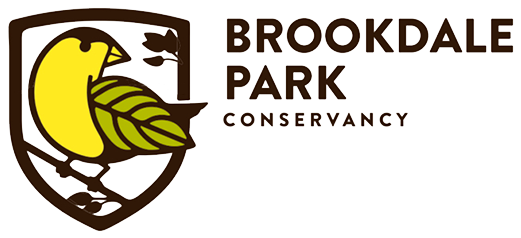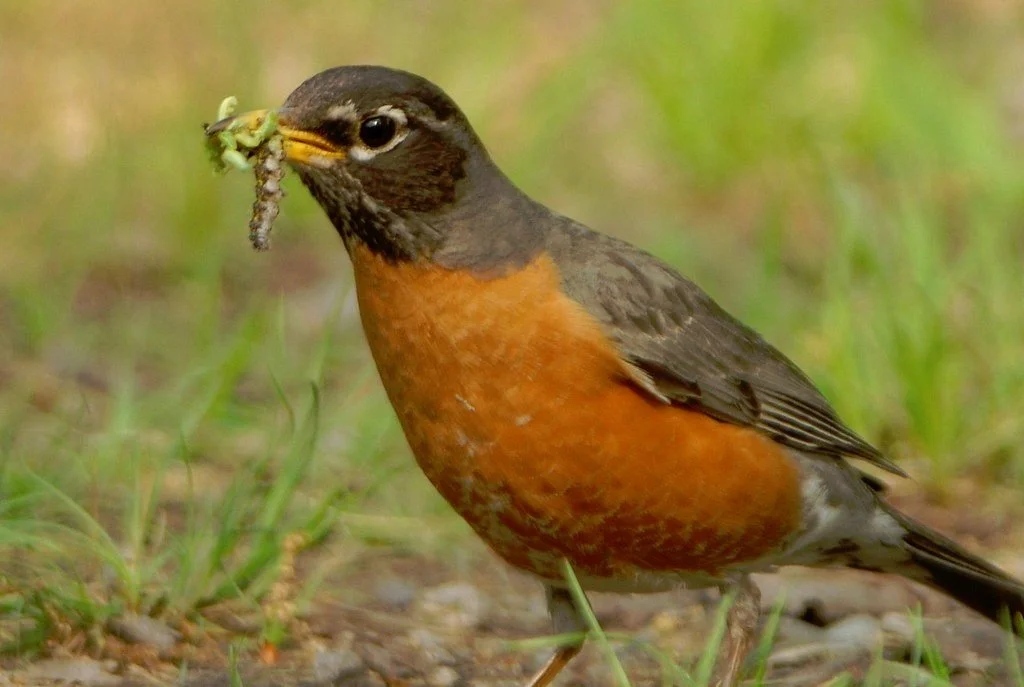by Sarah Paulson
Since beginning our monthly articles two years ago, our focus has primarily been on showcasing the park's many attractions. For example, last month Jean Greeley beautifully captured the enchantment of the Pollinator Garden in June. Through these articles, our aim is to inspire you to discover the park's wonders for yourself and to gain practical information for enhancing your gardens.
This month, I wanted to share how Brookdale Park and the Homegrown National Park movement inspired me to bring a bit of park magic into my home garden. Through sustainable landscaping practices and planting native shrubs and perennials, I have turned my property into a vibrant neighborhood for butterflies, moths, bees, ladybugs and birds. In effect, I’ve created my own park.
spicebush swallowtail caterpillar
One caterpillar that fascinates me is the spicebush swallowtail. Recently, I observed one in my yard on its preferred host plant, the spicebush. Those distinctive "eyes" aren't eyes at all; they're a defense mechanism to deter predators. Its real eyes are closer to its mouth and the size of a pinpoint. When not feeding, these caterpillars construct a hideout by folding over a leaf and securing it with silk, which has helped me to spot them more easily.
SHHH... Bees napping!
Many of our native bees take naps. Even the most jaded middle schoolers will get off my couch to search for napping bees. They are so cute splayed out on a flower or hanging upside down on a petal resting between pollen collection. The one pictured here on the lanceleaf coreopsis is a male squash bee. They spend most of their day resting in flowers. The females kick them out of the nest!
Fireflies
For the last couple of years, I’ve gathered the curbed leaf bags of my neighbors before the town whisks them away because I compost and the leaves are my carbon source. At first, I only took as many bags as I needed for composting year-round, but as my understanding grew of how wildlife depend on leaf litter to survive the winter, I decided to collect as many bags as my tiny property could hold. I spread the leaves in my plant beds as mulch and put the rest underneath my deck in a thin layer.
On a warm night this spring, I witnessed something amazing. I was walking my dog and as I left the house, I saw a myriad of flashing lights—fireflies were everywhere on my property. Last fall, we wrote about fireflies, and how the larvae spend up to two years in leaf litter eating and growing until they pupate and become adults. I kept walking down my street; the only house that had fireflies was mine. I had unintentionally created a firefly nursery by saving everyone’s leaves.
In recent years, I've noticed an increase in prophylactic mosquito spraying. While these treatments are often marketed as targeting only mosquitoes or being "organic," they are actually broad-spectrum pesticides that kill most insects, including pollinators and fireflies. These sprays also pose health risks to us and our pets.
Fortunately, there are more effective and cost-efficient methods to control mosquito populations.
I've adopted a few simple practices that have made a significant difference. After rain, I check my yard for standing water, as mosquitoes can lay up to 100 eggs in just a small puddle. I also had my gutters cleaned to ensure they drain completely after storms. Additionally, I've started using the "bucket of doom”. This involves filling a bucket with water and adding organic materials like hay, grass clippings, or leaves, along with a mosquito dunk (which I bought at the hardware store). The stagnant, fermenting water in the bucket becomes an attractive breeding ground for female mosquitoes. The mosquito dunk targets larvae, leading to their doom. (Hence, the catchy name.) Simply replace the dunk monthly and top off the water as needed.
My neighbor and I now use dual buckets of doom, and our combined efforts have proven even more effective. A coordinated plan among neighbors will have a much bigger impact than spraying.
By creating mini parks of our own and managing the land with simple, common sense practices, we can make a meaningful difference and foster a world where the beauty of our gardens and the well-being of wildlife go hand in hand.
Family Activity:
Learn more about the Homegrown National Park movement, join and register your property
To learn more about mosquito management, this lecture from Cary Memorial Library is helpful, as is this article from David Wasmuth of Northeast Earth Coalition.
Sarah serves as a board trustee at the Brookdale Park Conservancy, focusing on habitat restoration and community outreach. She is committed to fostering sustainable land management, connecting communities with nature, and contributing to environmental conservation.




